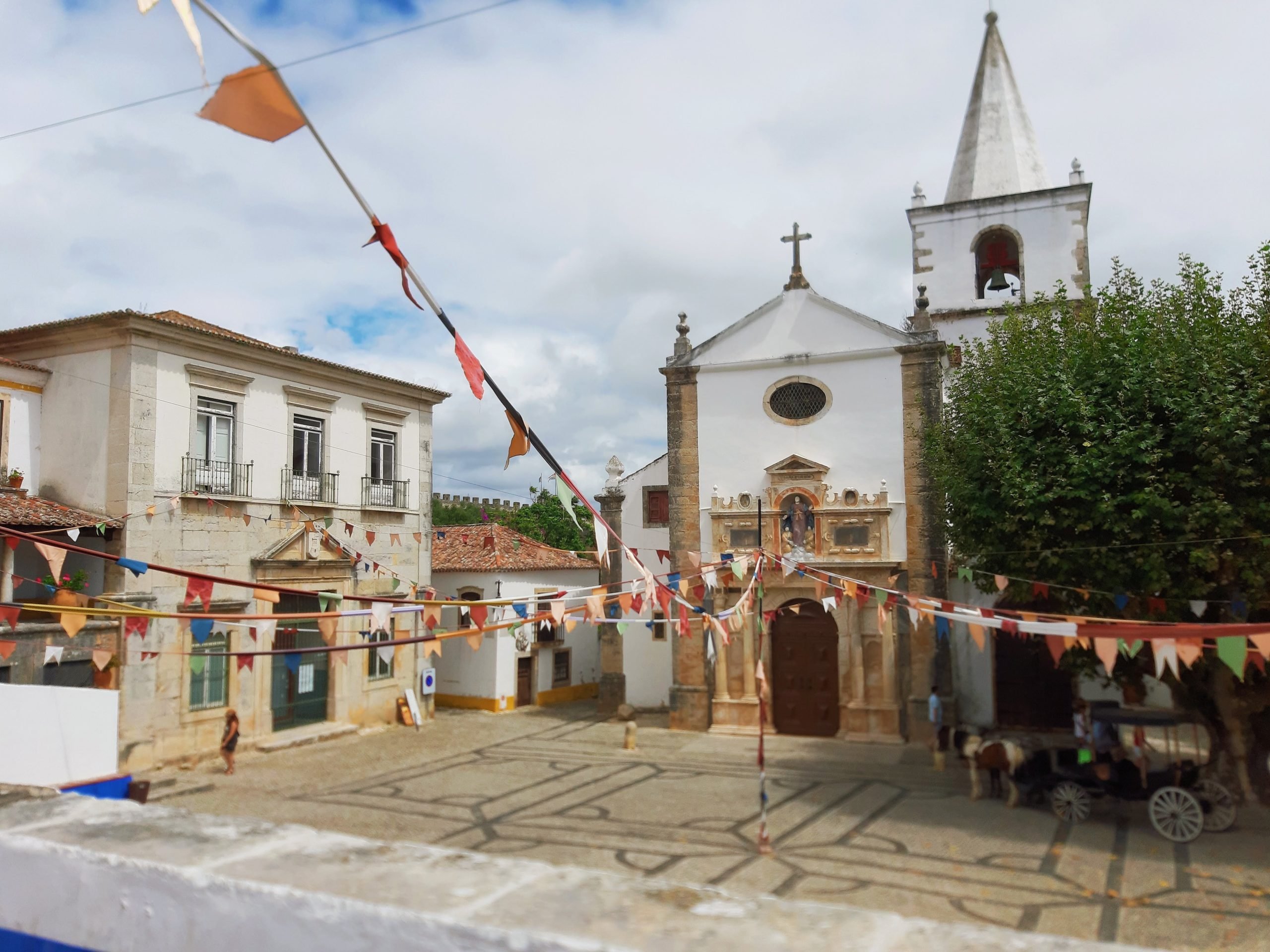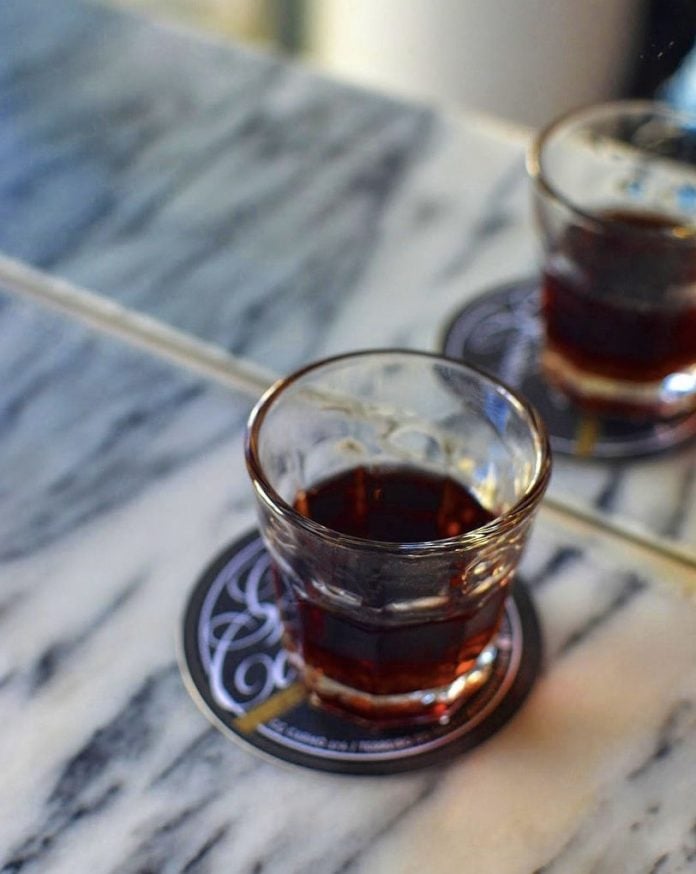Undoubtedly one of the most famous Portuguese liquors, known and loved all over Portugal, Ginjinha is starting to gain international notoriety. Ginjinha or just Ginja, is a liquor made out of Ginja berries, also known in English as sour cherry or by its scientific name Prunus cerasus. In this article, we’ll refer to “Ginja” as the fruit and “Ginjinha” as the drink, even though Ginja can be both.
Ginjinha is made by infusing the sour cherries in alcohol (aguardiente, loosely translated as firewater, a very strong spirit) and adding sugar as well as other ingredients. This produces a rich ruby-red drink that can be enjoyed as both an aperitif and digestif. It’s served in a shot form, sometimes in a chocolate glass or with a sour cherry on the cup.
The recipe for ginjinha is still a secret, but many people try to make their own, especially in the communities where it’s most famous, such as Lisbon, Óbidos, Alcobaça, Covilhã, Marvão, and the Algarve. The Serra da Estrela ginja, the one popular in Covilhã, is a protected designation of origin.
The production of these liquors made from fruits is thought to go back to ancient times when these were thought to be medicinal and to cure many diseases. Today, it’s simply appreciated for its good taste!
History of Ginjinha
It’s hard to know exactly where the Ginja cherries were born. It is thought that they came from Asia Minor, near the Caspian Sea. They spread to Portugal through commercial routes, such as the Silk Road, that connected this area to Europe. Soon, this fleshy cherry became available in the Mediterranean areas.
In the 1st century, Pliny the Elder, a very well-known Roman naturalist, writer, and natural philosopher, praised the Lusitanian Ginjas (Lusitania being roughly the area that now Portugal occupies).
As to how the liquor was born, is also a mystery, with each place having its own story. However, what is mostly accepted is that it came from ancient practices of mixing fruits with alcohol, as said earlier, having been perfected by the various religious orders.
The drink became a success and Ginjinha became a typical drink in the country!
Both Alcobaça and Óbidos claim to have been the original place where the ginjas were grown, with Alcobaça locals even saying that they were the ones that taught the people from Óbidos how to farm it. This is because both cities are known to have the best Ginjinhas, since they are very specific. Their microclimates create the best wild Ginjas in Europe, which is why they’ve applied for a PGI (Protected Geographical Indication, or ‘Indicação Geográfica Protegida’ in Portuguese) status in 2013.
The truth is, Óbidos became the most well-known and now, it’s an ex libris of the famous walled city! It was here that the idea of serving Ginjinha in an edible chocolate cup was born, making it even more known than the other Ginjinhas.
Nowadays, around 150.000 liters of Ginjinha are produced per year, with around 90% being consumed in Portugal and the rest being exported, mainly to the US.
Production of Ginjinha
The recipes change depending on the Ginja that we are talking about. The Alcobaça ginja has a different technique from the Óbidos ginja. However they all remain a secret of the producers, so we can only know a small part of these recipes. The Morello cherries are usually harvested around June. After this, they are mixed with several ingredients, such as water, cinnamon, and sugar (and possibly others). They are then left to infuse with aguardente for around 5 months.
Drinking Ginjinha: How to Drink Ginjinha
Ginjinha can be enjoyed at any time of the day, even in the morning! There is no cultural norm surrounding this. Usually, you will drink it in a small cup, like a shot glass, although you may be served one in a plastic cup. This is because most bars that serve it are very small and most people drink this liquor outside, so many bar owners lost their cups since people sometimes stole them as a souvenir. It usually costs around 1 euro (maximum 2) in Lisbon, so it’s as dangerously cheap as it is tasty.
However, as said previously, if you go to Óbidos there is a great chance that you will be served in an edible chocolate cup, as is traditional in this city. Nowadays, it’s starting to be done in other places too, like in Lisbon, due to the popularity that the chocolate cup has reached.
When you are ordering a Ginjinha, the seller will probably ask you “Com elas ou sem elas?”, meaning “With them or without them?”. This is regarding the Ginja cherry, if you want the drink with the cherry inside or not. It’s traditionally served with the cherry since it’s fun to suck on the cherry afterward, but no one will judge you if you don’t want it!
These days there have been many reinventions of the Ginjinha, with many cocktails and other drinks having been made using the liquor. Ginjinha da Sé, in Alfama, Lisbon is known to produce many of these, such as a ginja-mojito or ginja tonic.
Ginjinha de Alcobaça
In Alcobaça, the Ginjinha is said to have come from the Cistercian Monks, who had a famous monastery there since the 12th century. Until today it’s still produced using only natural ingredients. It has a ruby color with a strong taste of cherry.
Book Tours & Activities in Alcobaça
Ginjinha de Óbidos
In Óbidos, the story goes that it came from ancient religious orders, in the 17th century, but it was the various family-owned businesses competing to get the title of “the” Ginjinha de Óbidos that have perfected the recipes.
After the priests discovered and sold it to the Óbidos locals, they started to produce it themselves and present it to their guests, especially the most renowned ones.
Then, the first bar that served Ginjinha opened when the city became a tourist known spot, by a known storyteller from the city named Montez. The drink then became known to outsiders and tourists and more bars started to open. This made the competition grow inside the walled city for the best Ginjinha, making it either more or less alcoholic or more or less sweet.
Book Tours & Activities in Obidos
And today we have our beloved Ginjinha de Óbidos! The production starts on the farms. After being harvested, a maceration process happens that takes at least one year and produces a completely natural liquor.
This liquor is very strong in flavor and of a very dark red color. There are 2 varieties: the ‘simple’ liquor and the flavored with vanilla and a cinnamon stick. And of course, in Óbidos, you can’t forget the chocolate cup.

Ginjinha de Lisboa
In Lisbon, the legend stands that the drink was discovered by a Galician friar, who stayed in the Church of Santo António of Lisbon, named Francisco Espinheira. He experimented with leaving the sour cherries in aguardente, adding sugar, water, and cinnamon, and created this wonderful drink!
Book Tours & Activities in Lisbon
The Ginjinha da Praça de São Domingos in Lisbon is known to be the first store in the city to sell this drink, and it became a huge success. Nowadays, it’s a must drink when you visit Lisbon, where you will find multiple bars dedicated solely to it.

Ginjinha da Serra da Estrela
Ginjinha from Serra da Estrela is made from the maceration and infusion of the sour cherries planted in Cova da Beira in cereal distillate. This Ginja has a wonderful balance between the sweetness of the liquor itself and the natural sour touch of the ginja cherry.
Book Tours & Activities in Serra da Estrela
As said before, it’s a protected designation of origin. So if you’re ever in that area of Portugal, remember to have your glass of Ginjinha. This little shot-like drink is sure to leave you with a wonderful taste of Portuguese culture. Being a liquor usually drunk in the community, savor it and share it with your friends or with the locals, who will surely love to drink one with you!

You can also find it in different parts of the country, especially in more touristic and bigger cities, like Porto, due to the popularity of the drink in the country and because it’s just starting to be discovered by the tourists and foreigners.
So, cheers! Or as it’s usually said in Portugal: Saúde!


